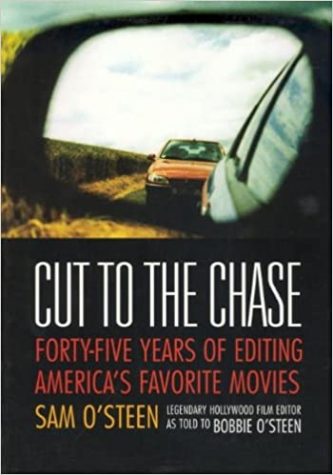 By SAM O’STEEN, BOBBIE O’STEEN (Michael Wiese Productions; 2001)
By SAM O’STEEN, BOBBIE O’STEEN (Michael Wiese Productions; 2001)
A movie book that’s as gossipy, informative and entertaining as anyone could possibly want. It consists of an extended interview with the late film editor Sam O’Steen shortly before his 2000 demise, conducted by his wife Bobbie, who assisted her spouse in his editing career and asks a number of leading questions.
O’Steen’s answers are related in a blunt, salty manner that bespeaks his four decades of labor in the Hollywood trenches. This entails attitudes and observations that are politically incorrect by modern standards, but I for one appreciated his honesty (fact: Hollywood is not and never was a very nice place).
The interviews take us through most of the thirty major films O’Steen edited (which include classics like WHO’S AFRAID OF VIRGINIA WOOLF?, ROSEMARY’S BABY, THE GRADUATE, CARNAL KNOWLEDGE and CHINATOWN), as well as the ones upon which he worked as an assistant early in his career (such as BLOOD ALLEY, THE WRONG MAN and THE STERILE CUCKOO) and the eight films he directed (which include QUEEN OF THE STARDUST BALLROOM, SPARKLE and THE BEST LITTLE GIRL IN THE WORLD).
O’Steen has a lot to say about the mechanics of film editing. His insights on what makes a sequence work, and how best to parcel out dialogue, reaction shots, etc., are film school-worthy, with the question-and-answer format ensuring that his descriptions never grow too technical.
Nor does this book doesn’t skimp on the lurid details. The close relationships O’Steen enjoyed with directors like Mike Nichols and Roman Polanski, and the vast esteem in which he was held by the Hollywood community, allowed him direct access to the shooting of the films he edited, resulting in some juicy revelations.
Among the dirt he provides are decidedly unflattering depictions of John Wayne, Dustin Hoffman (“a pain the ass”), Mia Farrow, Rip Torn, Jack Nicholson and even O’Steen’s longtime pal Mike Nichols (who’s chided for being “lazy” during the shooting of WOLF), while his portrayal of Roman Polanski is, conversely, very likely the most positive depiction you’ll ever read of that contentious figure (“He’s just a great guy, real witty and fun to be around”). There’s also a great deal of wordage lavished on the 1979 Dino de Laurentiis disaster HURRICANE, whose production, according to O’Steen’s recollections, was even more calamitous than what ended up onscreen.
In keeping with the frankness of his recountings, O’Steen is quite sanguine about the role of an editor on a movie. He understands that film is a director’s medium, with the editor on hand to assist in realizing that vision, but he’s not above overriding a director’s wishes or reshaping a film entirely (as he claims to have done with 1989’s A DRY WHITE SEASON). More than one filmmaker has called this book the definitive print resource on film editing, and I’ll have to agree.
